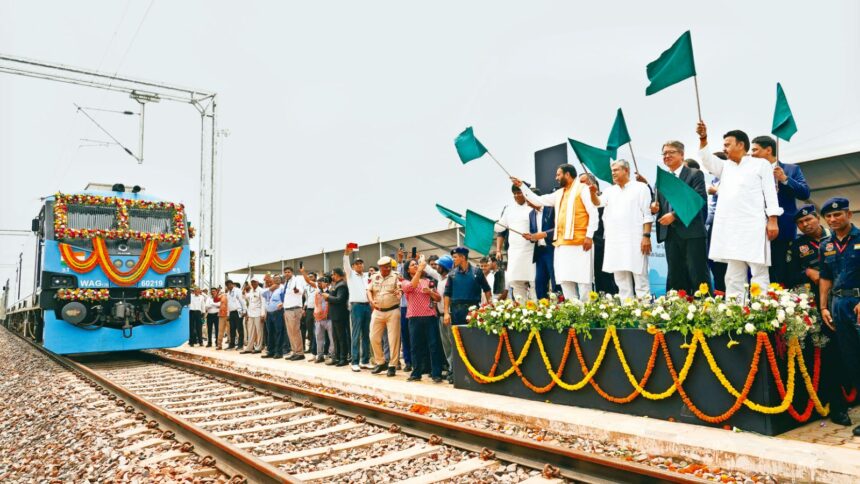In a significant step to increase the transportation of passenger vehicles or cars by Indian Railways, Union Minister for Railways, Information & Broadcasting and Electronics & Information Technology, Ashwini Vaishnaw Tuesday inaugurated the country’s largest automobile Gati Shakti Multi-Modal Cargo Terminal (MMCT) at Maruti Suzuki India Ltd facility in Manesar, Haryana.
Haryana Chief Minister Nayab Singh Saini and India’s CEO and managing director Hisashi Takeuchi were also present at the inauguration.
Maruti Suzuki is the biggest manufacturer for car loading in Indian Railways. The Manesar in-plant railway siding has a total dispatch capability of 4,50,000 vehicles annually at full capacity. It is company’s second in-plant railway siding facility.
Vaishnaw said the Railways undertook major reforms in 2021 to strengthen multi-modal logistics, resulting in the construction of 108 MMCT in a short span of time. “The terminal in Haryana, where the announcement was made, is spread over 45 acres and has a cargo handling capacity of up to 4.5 lakh cars… Legacy problems accumulated in Railways over the years are now being eliminated one by one. Stations, trains, toilets, tracks, cleanliness, technology — every sector has been improved comprehensively. New facilities are being provided to passengers and integrated development is being given priority in collaboration with the industry,” said Vaishnaw while addressing the gathering.
The Manesar plant is connected to Patli railway station through a 10 km dedicated rail link. It is part of 121.7 km Haryana Orbital Rail Corridor (HORC), which is being developed by the Haryana Rail Infrastructure Development Corp (HRIDC). Officials said that the 10 km railway line was developed at a cost of Rs 800 crore, of which Rs 684 crore was paid by HRIDC and the remaining by Maruti Suzuki. HRIDC is a joint venture of the Government of Haryana (51 per cent) and the Ministry of Railways (49 per cent).
HORC is being developed to decongest the Railway Network by diverting the railway traffic not meant for Delhi.
“On June 17, the vehicles were dispatched to 17 hubs or railway slidings to cater to 380 cities. The siding at the Maruti Suzuki’s Manesar plant comprises four lines and two loading platforms. The biggest benefit of new siding will be the direct loading of the car consignment from the plant. It will end the need for transportation by road to Farukhnagar, Bawal, Palhawas or Gurugram stations. In all, it will reduce a total of. 65,000 truck trips per annum, reducing the congestion on road and saving fossil fuels,” said a senior official at the Ministry of Railways.
The total loading of cars in the Indian Railways has crossed the 1 million target, the official added.
“The Rail Coefficient of India Railways has increased from 1.2 per cent in 2013-14 to 20.6 per cent in 2024-25. It means out of total car production in India, 20.6 per cent is being transported by the railways. In 2024-25, the total car production was 50.61 lakhs and out of this, 10.41 lakhs were transported by railways. It is mostly for domestic sales. Almost 50 per cent of total car loading is done by Maruti Suzuki,” said the official quoted above.
Maruti Suzuki’s Manesar facility was inaugurated in February 2007. Apart from this, India’s largest car manufacturer has three more plants in Gurugram, Gujarat and Kharkhoda.
“The project (in-plant railway siding) underscores our strong commitment to India’s Net Zero emissions target 2070. It will contribute to avoiding 1,75,000 tonne of CO2 emissions, saving 60 million litre of fuel annually at full capacity, and reducing road congestion. Lowering carbon emissions remains a top priority at Maruti Suzuki and we aim to achieve this, by increasing the share of vehicle dispatches through railways to 35 per cent by FY 2030-31,” said Hisashi Takeuchi, MD & CEO, Maruti Suzuki India Ltd.








